An Examination of Anderson's Chronological Errors
Regarding Daniel 9's First 69 Weeks
by Bob Pickle
-
Dispensationalism's Assumption About the First 69 Weeks
- Anderson's Theory Described
- Wrong Number of Leap Years
- Wrong Day to Start From
- Wrong Month to Start From
- Wrong Year to Start From
- Try a Different Year?
- Wrong Day to End With
- Wrong Year to End With
- Ignores the Sabbatical Cycle
- Conclusions
Dispensationalism's Assumption
About the First 69 Weeks
It was in the first half of the nineteenth century that John Nelson
Darby fathered the theory known as "dispensationalism." This theory is a
package consisting of several integrated components which include the following ideas:
The first 69 weeks of Daniel 9 began with the 20th
year of Artaxerxes and ended about the time of the crucifixion of Christ. The 70th week is yet future. The prince that confirms the covenant in Dan. 9:27 is
a future antichrist who will stop the sacrifices in a rebuilt temple
in Jerusalem. Prophecy ceased when the Jews rejected Christ. Prophecy will resume after the secret rapture. We are living in the church age during which salvation
is dealt with quite differently than at a previous time.
Much of the theory of
dispensationalism rests upon the assumption that we can make the first 69
weeks of Daniel 9's 70 weeks fit some sort of timeline from Artaxerxes'
20th year to Christ's time. Often when one discusses the details of
the first 69 weeks with a dispensationalist, the dates and theories of Sir Robert Anderson
arise, as outlined in his
book, The Coming Prince.
Anderson's Theory Described
Anderson, like all expositors, considered the 69 weeks
(483 days) to really be 483 years. He then multiplied these 483 years by
what he called a "prophetic year," a 360-day year. This gave
him a total of 173,880 days, and effectively shortened the time period
down to about 476 actual years, since a 360-day year is shy of the true solar
year by over 5 days.
Anderson felt that 445 BC must have been Artaxerxes' 20th year of
reign. Nehemiah. 2:1 says that it was in the month Nisan that Nehemiah received
his commission from Artaxerxes. Anderson assumed this meant Nisan 1, and
then tried to ascertain what that date might be:
Now it is an undisputed fact that Jerusalem was rebuilt by Nehemiah,
under an edict issued by Artaxerxes (Longimanus), in the twentieth year
of his reign. . . . But the month date was
Nisan, and the sacred year of the Jews began with the phases of the
Paschal moon. I appealed, therefore, to the Astronomer Royal, the late
Sir George Airy, to calculate for me the moon's place for March in the
year in question, and I thus ascertained the date required — March
14th, B.C. 445. (p. 25)
Anderson even reproduces the letter he got from Sir George Airy:
"ROYAL OBSERVATORY, GREENWICH.
"June 26th, I877.
"SIR, — I have had the moon's place calculated from Largeteau's
Tables in Additions to the Connaisance des Tems 1846, by one of my
assistants, and have no doubt of its correctness. The place being
calculated for — 444, March 12d. 20h., French reckoning, or March 12d.
8h. P. M., it appears that the said time was short of New Moon by about
8h. 47m., and therefore the New Moon occurred at 4h. 47m. A. M., March
13th, Paris time.
"I am, etc.,
" (Signed,) G. B. AIRY."
The new moon, therefore, occurred at Jerusalem on the 13th March, B.
C. 445 (444 Astronomical) at 7h. 9m. A. M. (pp. 223, 224)
Notice that Airy only said when the new moon was. He said
nothing about when Nisan 1 was.
Now counting 173,880 days from this date of March 14th, Anderson continues:
5. The Julian date of 1st Nisan 445 was the 14th March.
6. Sixty-nine weeks of years — i.e. 173, 880 days —
reckoned from the 14th March B.C. 445, ended on the 6th April A.D. 32. (p. 6)
Now 483 years (69 × 7) of 360 days contain 173, 880 days. And a
period of 173, 880 days, beginning March 14th, B.C. 445, ended upon that
Sunday in the week of the crucifixion . . . . (p. 25)
Or Palm Sunday.
The Julian date of that 10th Nisan was Sunday the 6th
April, A.D. 32. What then was the length of the period intervening between
the issuing of the decree to rebuild Jerusalem and the public advent of
"Messiah the Prince," — between the 14th March, B.C. 445, and the
6th April, A.D. 32? THE INTERVAL CONTAINED EXACTLY AND TO THE VERY DAY
173, 880 DAYS, OR SEVEN TIMES SIXTY-NINE PROPHETIC YEARS OF 360 DAYS, the
first sixty-nine weeks of Gabriel's prophecy. (p. 91)
Now watch closely as Anderson makes his calculation:
The intervening period was 476 years and 24 days (the days
being reckoned inclusively, as required by the language of the prophecy,
and in accordance with the Jewish practice).
| |
But 476 × 365 =
Add (14 March to 6th April, both inclusive)
Add for leap years
|
173,740
24
116 |
days
days
days |
 |
| | TOTAL DAYS |
173,880 |
And 69 weeks of prophetic years of
360 days (or 69 × 7 × 360) 173, 880 days. (p. 224)
That is Sir Robert Anderson's theory about the first 69 weeks, and it
doesn't hold water.
Wrong Number of Leap Years
The first problem that is readily apparent about Anderson's scenario
was his confusion about the Julian and Gregorian calendars.
And secondly, the Julian year is 11m. 10 46s., or about the 129th
part of a day, longer than the mean solar year. The Julian calendar,
therefore, contains three leap years too many in four centuries, an
error which had amounted to eleven days in A. D. 1752 when our English
calendar was corrected by declaring the 3rd September to be the 14th
September, and by introducing the Gregorian reform which reckons three
secular years out of four as common years; ex. gr., 1700, 1800 and 1900
are common years, and 2000 is a leap year. (p. 225)
This is true. But then why did Anderson use Gregorian years when
calculating the number of days between two Julian dates? If we use
Julian dates, we must use Julian years, and if we use Gregorian dates, we
must use Gregorian years. We cannot mix the two calendars in the way that
he proposes.
Anderson
was thus 3 days off in his calculation, for there are really 173,883 days
inclusive between Friday, March 14, 445 BC, and Sunday, April 6, 32 AD.
Instead of adding 116 days for leap years, Anderson should have added 119, for
that is precisely how many leap years there are in 476 years in the Julian
calendar.
If Anderson had wanted to use Gregorian years, he should have started off
with the Gregorian dates of Saturday, March 9, 445 BC, and Sunday, April 4, 32 AD
(Mar. 9, 445 BC Gregorian = Mar. 14, 445 BC Julian; Apr. 4, 32 AD Gregorian = Apr. 6,
32 AD Julian).
But when we add 116 days for leap years to the number of days between these two dates,
we still end up with 173,883 days.
Only by mixing the two calendars does it falsely appear that there are 173,880 days.
(See Figures 1 and 2.)
Another freeware program is Online
Bible. You can use its Astro-Calendar module
to ascertain dates for new moons,
to convert Gregorian dates to Julian and vice versa, and to verify the
Julian Day number for any date in history. Finding the difference between two Julian Day numbers
is the easiest way to compute the number of days between two dates.
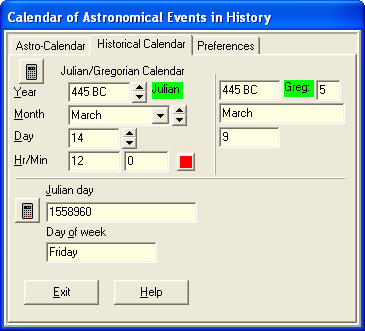 |
|
Figure 1. Above is a snapshot of the Astro-Calendar module of Online Bible,
with some of the extra info trimmed away. Notice that March 14, 445 BC, in the Julian calendar is
March 9 in the Gregorian calendar, and the Julian Day number for that date is 1558960.
|
|
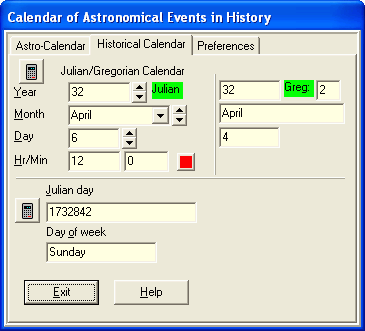 |
|
Figure 2. April 6, 32 AD, in the Julian calendar is April 4 in the Gregorian calendar,
and has a Julian Day number of 1732842. The difference between the Julian dates of
March 14, 445 BC, and April 6, 32 AD,
can easily be calculated by finding the difference between their Julian Day numbers:
1732842 − 1558960 = 173,882. Thus, the difference inclusive
is 173,883 days, not 173,880 as Anderson supposed.
|
|
Wrong Day to Start From
Nor was this Anderson's only error. If the new moon occurred at 7:09 AM on March 13, 445
BC, as he supposed, the new crescent would not be old enough and large enough and far
enough away from the setting sun by that evening to be seen. As Anderson
himself quotes:
"The month began at the phases of the moon . . . and this happens,
according to Newton, when the moon is eighteen hours old.
. . ." (p. 217)
At sunset on the evening of March 13th it would have been
but 11 hours old, too young to be seen. Thus the new month could not
have begun until the evening of March
14th, making March 15th the first day of the new month, not March 14th.
Jewish months back then, as Islamic months do today, began when the new
crescent moon could barely be seen with the naked eye soon after sunset. MoonCalc
is a freeware Islamic calendar program one can use to calculate when the
new crescent can first be seen, weather permitting. You can download this
program by clicking either here
or here.
Figure 3 contains a screenshot of its calculations for when the new crescent
can be seen in March of 445 BC.
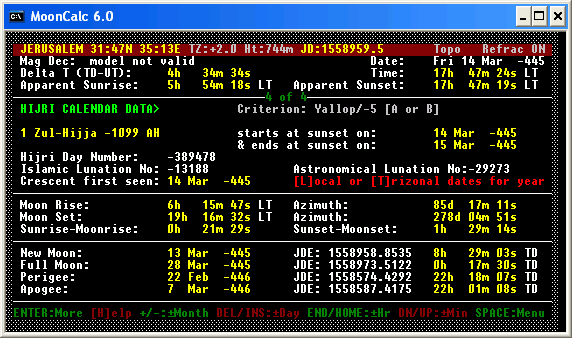 |
|
Figure 3. MoonCalc does not allow dates prior to 500 AD, but
it will go back one month at a time to any date desired. We therefore went back one month
at a time to March 445 BC and discovered that the first of the month fell on
March 15, not March 14.
|
|
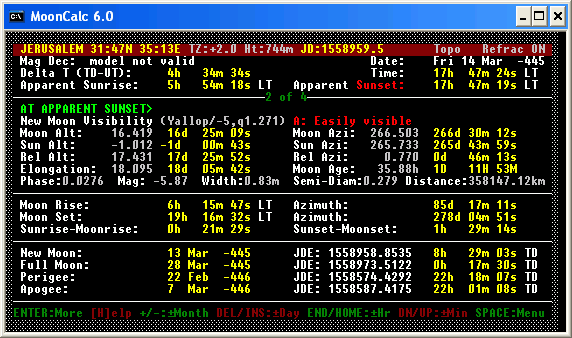 |
|
Figure 4. Here MoonCalc tells us that the moon was almost 36 hours old
at apparent sunset, explaining in part why it was so easily seen after sunset on March 14.
The previous evening it would have been but about 12 hours old.
There is always the possibility that a cloudy night could prevent the sighting of the
crescent, and thus delay the start of the month by an additional day. That possibility does not help
Anderson's position, since it would make the first of the month fall on March 16.
|
|
Wrong Month to Start From
We have two resources that tell us something about the calendar back in
the 5th century BC: Jewish scribal papyri from Elephantine, Egypt, and
cuneiform tablets from Mesopotamia. Both indicate that March 14 is too
early in the year to be considered Nisan, the first month of the Jewish year. At
Elephantine, Nisan 1 ranged from March 26 (in 446 and 428 BC) to April 24
(in 465 BC) (Siegfried Horn and Lynn Wood, The Chronology of Ezra 7,
p. 157-159). In Babylonia, Nisan 1 ranged from March 26 to April 23 for the
years 464 BC to 400 BC (Richard Parker and Waldo Dubberstein, Babylonian
Chronology, p. 32, 33). Thus in 445 BC, Nisan would have begun after the new moon
of April, not after the new moon of March, making April 13 Nisan 1, not March 14.
Besides, it is hard to conceive how the barley could have been ripe
enough for the wave sheaf offering that took place on Nisan 16 if Nisan 1
was as early as March 14. That date is just too early in the year.
Wrong Year to Start From
Another error concerns the date of 445 BC. One issue involved with this
is when Artaxerxes took the throne. According to Anderson:
The murder of Xerxes and the beginning of the usurper Artabanus's
seven months' reign was in July B.C. 465; the accession of Artaxerxes
was in February B.C. 464; one or other of these dates, therefore, must
be the epoch of Artaxerxes' reign. (The Coming Prince, p. 63)
It is not known for sure when Xerxes was murdered.
According to Aramaic Papyri 6 from Elephantine, the date of January
2/3, 464 BC, was in Artaxerxes' accession year (The Chronology of Ezra
7, p. 100-102). What was his "accession year"? That would be the time
between the previous king's death and the next New
Year's Day. Artaxerxes' year 1 would thus have begun with the following Nisan
(March/April) in the Persian calendar and the following Tishri
(September/October) in the Jewish calendar.
Anderson says:
But as Nehemiah mentions the Chisleu (November) of one year, and the
following Nisan (March) as being both in the same year of his master's
reign, it is obvious that, as might be expected from an official of the
court, he reckons from the time of the king's accession de jure,
that is from July B.C. 465. The twentieth year of Artaxerxes therefore
began in July B.C. 446, and the commandment to rebuild Jerusalem was
given in the Nisan following. The epoch of the prophetic cycle is thus
definitely fixed as in the Jewish month Nisan of the year B.C. 445. (p. 63)
Yet since Persian practice was to number the years of their kings from Nisan,
not from their anniversary dates, Anderson's explanation must be wrong.
What these verses in Nehemiah really
show is that the Jews, in contrast with the Persians, numbered the reigns
of foreign kings from their 7th month called Tishri instead of from their
1st month called Nisan. Every 7th month, the king's
regnal year increased by one. This is why Nehemiah describes the 9th month
Chisleu as coming before the 1st month Nisan.
If Tishri 464 BC began the 1st year of Artaxerxes, then Tishri 445 BC
began his 20th year. And that means that Nisan in his 20th year fell in
444 BC, not 445 BC. So Anderson was a year off on his starting date.
Try A Different Year?
You might wonder if Anderson could have started with 444 BC and ended
with 33 AD, especially since 33 AD is considered to be one of the possible
years of Christ's crucifixion. The answer is no.
First of all, if we count backward from the proposed date of the crucifixion
in March of 33 AD, we end up having to celebrate the Passover around a Julian date of
March 18 in 444 BC, which corresponds to a Gregorian date of March 13. However,
there is absolutely no way that Jews in 445 BC
celebrated the Passover eight days before the spring equinox. That is way too early.
We thus must settle for a Nisan 1 that fell no earlier than April 3, 444 BC.
It was on the evening of April 2, weather permitting, that the new crescent was first
seen, which would make April 3 Nisan 1. 173,880 days later, counting inclusively as
Anderson suggested, brings us to Thursday, April 23, 33 AD.
Since the new crescent could not have been seen before the evening of
Saturday, April 18, in 33 AD, that would make Nisan 1 fall on Sunday, April 19, or perhaps a day later,
and Nisan 5 on Thursday, April 23, or perhaps a day later. Thus Thursday, April 23,
could not have been Palm Sunday on Nisan 10.
Worse yet, Nisan 14 would have fallen on Saturday, May 2, or perhaps a day later.
But if Nisan 14 fell on a Saturday or Sunday in 33 AD, how could Christ have died on
a Friday if He died in that year? Even a hypothetical Wednesday crucifixion does not work
when Nisan 14 falls on a Saturday or Sunday.
The only two possible schemes to make dispensational interpretations of the 69 weeks work
is to start either in 445 or 444 BC. If
neither one fits, as they most certainly do not, Anderson's theory is
proven false.
Wrong Day to End With
The previous section hints at the problems we face with Anderson's
ending date of April 6, 32 AD. His theory called for it to be Nisan 10. He
explains it this way:
For example, in A.D. 32, the date of the true new moon, by which the
Passover was regulated, was the night (10h 57m) of the
29th March. The ostensible date of the 1st Nisan, therefore, according
to the phases, was the 31st March. It may have been delayed, however,
till the 1st April; and in that case the 15th Nisan should apparently
have fallen on Tuesday the 15th April. (p. 79)
Thus far his explanation proves that he has chosen the wrong date for
the 10th of Nisan. If Nisan 15 fell on April 15, then Nisan 10 fell on
April 10, not April 6.
Continuing:
But the calendar may have been further disturbed by intercalation.
According to the scheme of the eight years' cycle, the embolismal
month was inserted in the third, sixth, and eighth years, and an
examination of the calendars from A.D. 22 to A D. 45 will show that A.D.
32 was the third year of such a cycle. As, therefore, the difference
between the solar year and the lunar is 11 days, it would amount in
three years to 33 3/4 days, and the intercalation of a thirteenth month
(Ve-adar) of thirty days would leave an epact still remaining of
3 3/4 days; and the "ecclesiastical moon" being that much
before the real moon, the feast day would have fallen on the Friday
(11th April), exactly as the narrative of the Gospels requires. (pp. 79, 80)
If that didn't make sense, it's because it doesn't make sense. On
average, the Jews would add in a 13th month 7 times every 19 years. Since
this 13th month was the length of a lunar month, as Anderson admits above,
there was no "epact remaining." Thus Nisan 1 would still have
begun with observing the new crescent on the evening of March 31st,
weather permitting.
Nisan 10 occurred at the earliest on April 10, not April 6 as
Anderson supposed.
 |
|
Figure 5. April 1 was the first day of the Jewish month, making April 10, not April 6 the tenth day
of the month.
|
|
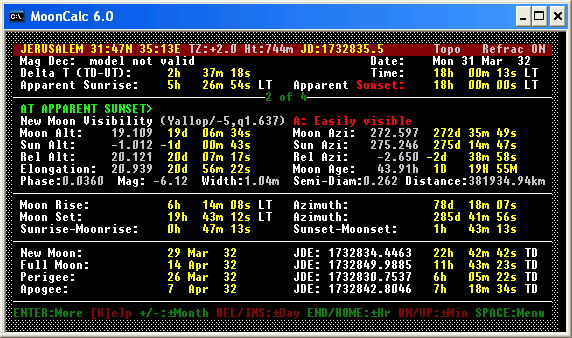 |
|
Figure 6. At apparent sunset the night of March 31, the moon was almost
44 hours old. Since it could not have been seen four days earlier,
April 6 could not possibly have been Nisan 10.
|
|
Wrong Year to End With
No one except those who ascribe to Anderson's theory suggest 32 AD as a
possible date for the death of Christ. The simple fact is that Nisan 14 in
that year would have been on a Monday or Tuesday.
It is simply impossible to reconcile this fact with the
gospel accounts of the death of Christ.
Ignores the Sabbatical Cycle
All agree that Daniel 9's 70 weeks are an allusion to the Jewish
practice, commanded in Leviticus 25, to not sow the ground every seventh
year. Thus in Daniel 9 we have 70 sabbatical cycles referred to. It would
make the most sense to begin these weeks with the beginning of the first
year of a seven-year cycle, and end them with the end of the seventh year
of a seven-year cycle.
The first sabbatical year after the cross, whenever that was, began in
the fall of 33 AD and ended in the fall of 34 AD (see
When
Were the Sabbatical Years?). Assuming that this
marked the end of the 70th week, counting backwards from the fall of 34
AD, we arrive at the fall of 457 BC as the beginning of the first year of
a seven-year sabbatical cycle. As already brought out, Artaxerxes' 20th
year began in the fall of 445 BC. We find, therefore, that the fall of 457
BC would mark the end of his 7th year. It was during his 7th year that he
issued the decree now found in Ezra 7, which went into effect the
following fall.
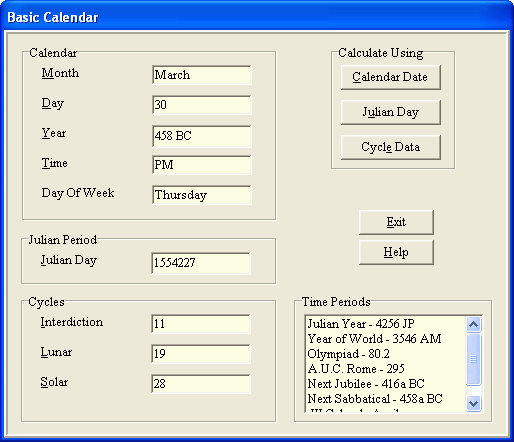 |
|
Figure 7. Above is a snapshot of the Calendar module of Online Bible.
The bottom left corner says that the next sabbatical year begins in 458a BC.
The "a" on 458 stands for October through December. Thus, the next sabbatical year
would be from the fall of 458 through the fall of 457 BC, making the fall of 457
the start of a new 7-year cycle.
|
|
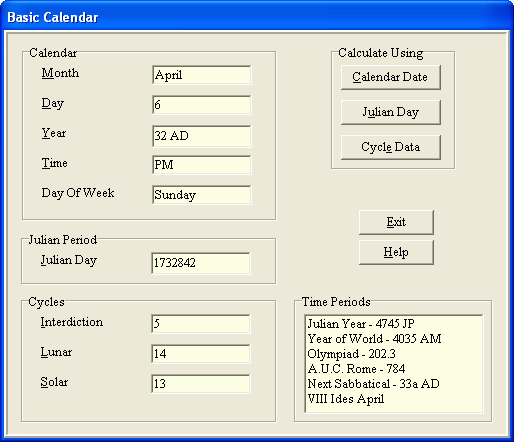
| |
Figure 8. The above shows that the fall of 33 AD to the fall of 34 AD was a sabbatical year.
Anderson's dates do not come close to lining up with the sabbatical cycles.
|
|
What we want to notice here is that Anderson's theory ignores these
sabbatical cycles. By reducing the 483 years to 476, and by stretching
what he called 69 weeks over really 68 weeks of years, Anderson totally
disregarded the sabbatical cycles. To be more specific, March 14, 445
BC, was in the middle of the 5th year of a sabbatical cycle, and April 6,
32 AD, was in the middle of the 5th year of a sabbatical cycle. Between
these two dates we have 68 sabbatical cycles, not 69.
Conclusions
- If we cannot find good beginning and ending dates for the first 69
weeks when placing the 70th week in the future, we had better keep all
70 weeks together as one unit.
- This means that the prince who confirms the covenant in Daniel 9:27
will have to be Christ instead of a future antichrist. This used to be
the predominant view anyway.
- What follows from this is that Christ's causing the sacrifices to
cease would need to be identified with His sacrifice at the cross
ultimately bringing an end to the Jewish sacrificial system.
- Since the fall of 34 AD marks the end of a sabbatical year, the
spring of 31 AD would mark the precise middle of the 70th week. We may
then look at this date as a possibility for the date of the
crucifixion.
- The prophecy should begin in the fall of 457 BC and be tied to
Artaxerxes' 7th year, not his 20th year.
To this may be added:
- Dating from Artaxerxes' 20th year has not been without difficulty in
the past, since there is no decree recorded from that year in the book
of Nehemiah.
- Daniel 9:25 specified two things for the decree that must be used
for the beginning of the prophecy: 1) "restoring" and 2)
"building" Jerusalem.
- It was prophesied of Cyrus that he would command Jerusalem to be
built: "That saith of Cyrus, He is my shepherd, and shall perform all my pleasure: even saying to Jerusalem, Thou shalt be built; and to the temple, Thy foundation shall be
laid" (Is. 44:28; cf. 45:13).
- It was also prophesied by Isaiah that God would "restore" Jerusalem's judiciary:
"And I will restore thy judges as
at the first, and thy counsellors as at the beginning: afterward thou shalt
be called, The city of righteousness, the faithful
city" (Is. 1:26).
- While Cyrus' decree of Ezra 1:2-4 and Darius' decree of Ezra 6:1-12
called for building, it is only in Artaxerxes' decree from his 7th
year, as recorded in Ezra 7:12-26, that we find a call for restoring
the judges.
- The decrees of Cyrus, Darius, and Artaxerxes' 7th year are referred to
in Ezra 6:14 as if they are but one
decree. It is as if Cyrus began the decree and Artaxerxes finished it, which explains why
Daniel 9:25 speaks of one "commandment to restore and build." Once this commandment
process was complete, the 70 weeks could begin.
The issue of the first 69 weeks is an important one. Because of the
problems cited above, much of dispensationalism's theology will need to be
rewritten.
|










